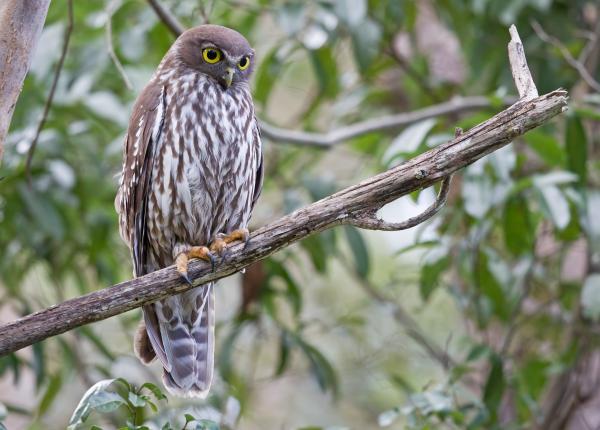Did You Know?
- There are four recognized subspecies of the Barking Owl
- The Barking Owl makes a wide range of vocalizations from barks and trills, to growls and screams!
How The Peregrine Fund is Helping
Though The Peregrine Fund does not work directly with Barking Owls, our efforts in scientific research, habitat conservation, education, and community development help conserve birds of prey around the world. We also supply literature to researchers from our avian research library, which helps scientists around the world gather and share important information on raptor conservation. Our support of the Global Raptor Information Network gives raptor researchers tools to more efficiently conduct their own studies while contributing to a global program. It also provides citizen scientists a way to participate in raptor science and conservation.
Where it Lives
Found in parts of Australia, N Moluccas and New Guinea, this beautiful owl lives in forested habitats, woodlands, farmlands and even urban areas, as long as there are enough trees around.
What it Does
As you would expect with a name like "Barking Owl," this owl's call does indeed sound like a medium-sized barking dog. Sometimes the male and female will call back and forth to each other in a lovely duet. Its vocal repertoire also includes a "scream" that has been likened to that of a human screaming. These owls are crepuscular, meaning they are active at twilight, and nocturnal.
Why it Needs our Help
The Barking Owl is categorized as a species of Least Concern globally. It is generally widespread throughout its range, but is population overall appears to be decreasing. And there are some areas where the species is more scarce. In New South Wales and southern Australia, it is categorized as Vulnerable. In Victoria it is categorized as Endangered. Habitat loss is a threat to this species as forests are cleared for development, farming, or cattle.
What it Eats
As you might expect, this owl is a keen hunter and is able to catch and consume a host of different animals. It hunts large insects, as well as mammals such as rabbits, bats and rodents, and it will also consume small to medium-sized birds. It hunts both terrestrial and arboreal animals, and will even catch bats and flying insects in the air.
Nests, Eggs, and Young
There is still so much for us to learn about the breeding biology of this species. We do know that they nest in large cavities in trees, on tree branches, or sometimes even on the ground. The female will lay between 1-4 eggs and the eggs must be incubated for about 5 weeks. When the owlets hatch, they are covered in creamy-white down. They will grow and develop quickly so that at around 35 days old, they are ready to fly from the nest for the first time. But, once they are out of the nest, they will remain with their parents for another several months as they learn to hunt, avoid danger, and otherwise survive on their own.
Barking Owl and the World Center for Birds of Prey
The World Center for Birds of Prey offers fun ways to learn about raptors. Interactive activities, tours, interesting videos and a children's room with activities from coloring sheets to quizzes to costumes await you. At our visitor center, you can see live owls up close - such as a Verreaux' Eagle-Owl or a Western Screech-Owl, and learn about the wonderful and interesting adaptations they have in order to survive in their respective habitats. There is also a touch table with owl feathers and other natural objects available for exploration. Though far from Barking Owl habitat, if you take a stroll along a short nature trail around the center, you may come across other owl species including Barn Owls or even a Northern Saw-whet Owl perched in the trees.
References:
BirdLife International. 2016. Ninox connivens. The IUCN Red List of Threatened Species 2016: e.T22689394A93229752. https://dx.doi.org/10.2305/IUCN.UK.2016-3.RLTS.T22689394A93229752.en. Accessed on 28 September 2022.
Olsen, P.D. and J. S. Marks (2020). Barking Owl (Ninox connivens), version 1.0. In Birds of the World (J. del Hoyo, A. Elliott, J. Sargatal, D. A. Christie, and E. de Juana, Editors). Cornell Lab of Ornithology, Ithaca, NY, USA. https://doi.org/10.2173/bow.barowl1.01










